ITC-505: Agile and Waterfall Methodologies for Project Success
VerifiedAdded on 2024/07/01
|9
|1001
|316
Report
AI Summary
This report provides a comparative analysis of Agile and Waterfall project management methodologies. It begins by defining project methodologies and then delves into the specifics of the Waterfall model, highlighting its sequential phases, advantages, and disadvantages. Subsequently, the report examines the Agile model as an incremental approach, emphasizing its iterative cycles, customer satisfaction benefits, and potential drawbacks. The report advocates for the Agile methodology due to its flexibility and customer-centric approach, illustrating how it integrates within the project lifecycle and software development lifecycle (SDLC). The document concludes by referencing sources that support the analysis and comparison of these two prominent project management methodologies. Desklib provides access to this document and other solved assignments for students.

P a g e | 1
ITC- 505
Assignment 1
ITC- 505
Assignment 1
Paraphrase This Document
Need a fresh take? Get an instant paraphrase of this document with our AI Paraphraser
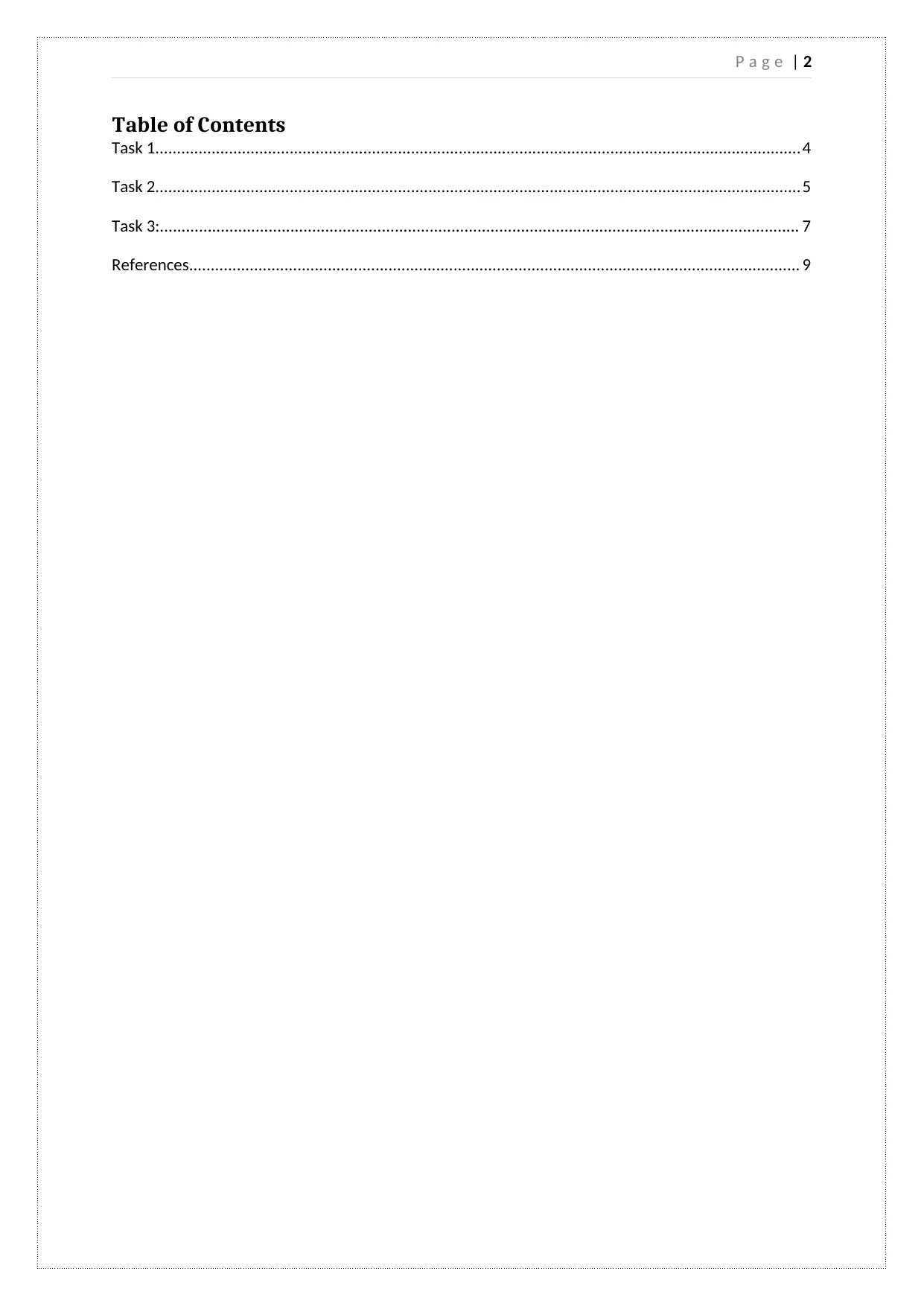
P a g e | 2
Table of Contents
Task 1.....................................................................................................................................................4
Task 2.....................................................................................................................................................5
Task 3:................................................................................................................................................... 7
References............................................................................................................................................. 9
Table of Contents
Task 1.....................................................................................................................................................4
Task 2.....................................................................................................................................................5
Task 3:................................................................................................................................................... 7
References............................................................................................................................................. 9
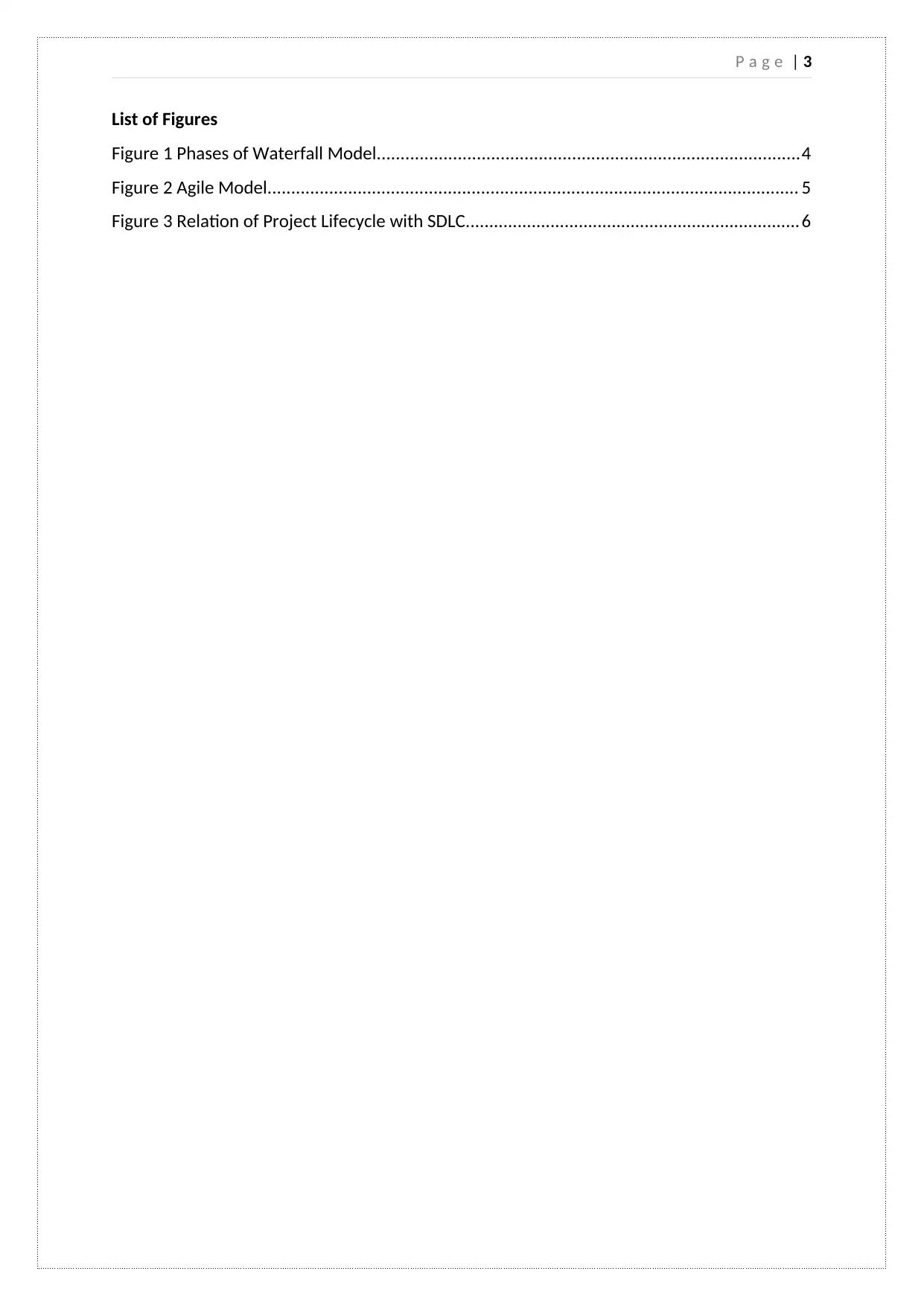
P a g e | 3
List of Figures
Figure 1 Phases of Waterfall Model.........................................................................................4
Figure 2 Agile Model................................................................................................................ 5
Figure 3 Relation of Project Lifecycle with SDLC.......................................................................6
List of Figures
Figure 1 Phases of Waterfall Model.........................................................................................4
Figure 2 Agile Model................................................................................................................ 5
Figure 3 Relation of Project Lifecycle with SDLC.......................................................................6
⊘ This is a preview!⊘
Do you want full access?
Subscribe today to unlock all pages.

Trusted by 1+ million students worldwide

P a g e | 4
Task 1
Project Methodology:
For achieving the goals and results in a specific period of time and budget, a project is used.
For every field, there are some defined methodologies that help the managers to implement
the project. These methodologies contain all the details for the system development right
from its starting to its ending. The methodologies are a kind of model which helps the
managers to achieve their project goals. There are various methodologies for various types
of projects.
Management of the project is the process of initiation, making plans, then executing it with
control and then closing the teamwork so as to achieve the defined goal and success in the
scheduled time. The methodologies consist of the guidelines for managing the project.
These help in accomplishing the goals together with meeting the expectations. It is
necessary to select the appropriate method for management of the project. The main
challenge of managing any project obtains all the defined goals in the given conditions and
constraints. There can be many constraints such as budget, quality, time and scope. There
are following methodologies for project development:
Agile
Kanban
Waterfall
Six Sigma
Scrum
DMAIC
PMBOK
SDLC
PRINCE2(Aston, 2017)
Task 1
Project Methodology:
For achieving the goals and results in a specific period of time and budget, a project is used.
For every field, there are some defined methodologies that help the managers to implement
the project. These methodologies contain all the details for the system development right
from its starting to its ending. The methodologies are a kind of model which helps the
managers to achieve their project goals. There are various methodologies for various types
of projects.
Management of the project is the process of initiation, making plans, then executing it with
control and then closing the teamwork so as to achieve the defined goal and success in the
scheduled time. The methodologies consist of the guidelines for managing the project.
These help in accomplishing the goals together with meeting the expectations. It is
necessary to select the appropriate method for management of the project. The main
challenge of managing any project obtains all the defined goals in the given conditions and
constraints. There can be many constraints such as budget, quality, time and scope. There
are following methodologies for project development:
Agile
Kanban
Waterfall
Six Sigma
Scrum
DMAIC
PMBOK
SDLC
PRINCE2(Aston, 2017)
Paraphrase This Document
Need a fresh take? Get an instant paraphrase of this document with our AI Paraphraser

P a g e | 5
Task 2
Waterfall Model: This was the very first model to get introduced. This model is easy to use
and understand. In this model, a new phase starts only after the previous phase completes.
This model is best suited to the projects small in size having all the predefined requirements
identified. After each phase, the previous phase is reviewed to ensure if this is what is
needed to be achieved or not. And if it does not fulfills the requirement then it is simply
discarded and a new model will be generated again. Testing is done after the development
of the project.
Advantages:
1. This is easy to use model.
2. More suitable for small projects.
Disadvantages:
1. It is difficult to backtrack from the testing phase.
2. High risk is associated with this model (Powell-Morse, 2017).
Figure 1 Phases of Waterfall Model
Agile Model: Agile is one of the Incremental models. The development of the software takes
place in incremented and rapid cycles. So with every increment, a small model is released.
These are then tested so as to ensure the quality of the software. It is best suited for the
applications which are time critical. It works best in the situations when the scope and time
Task 2
Waterfall Model: This was the very first model to get introduced. This model is easy to use
and understand. In this model, a new phase starts only after the previous phase completes.
This model is best suited to the projects small in size having all the predefined requirements
identified. After each phase, the previous phase is reviewed to ensure if this is what is
needed to be achieved or not. And if it does not fulfills the requirement then it is simply
discarded and a new model will be generated again. Testing is done after the development
of the project.
Advantages:
1. This is easy to use model.
2. More suitable for small projects.
Disadvantages:
1. It is difficult to backtrack from the testing phase.
2. High risk is associated with this model (Powell-Morse, 2017).
Figure 1 Phases of Waterfall Model
Agile Model: Agile is one of the Incremental models. The development of the software takes
place in incremented and rapid cycles. So with every increment, a small model is released.
These are then tested so as to ensure the quality of the software. It is best suited for the
applications which are time critical. It works best in the situations when the scope and time
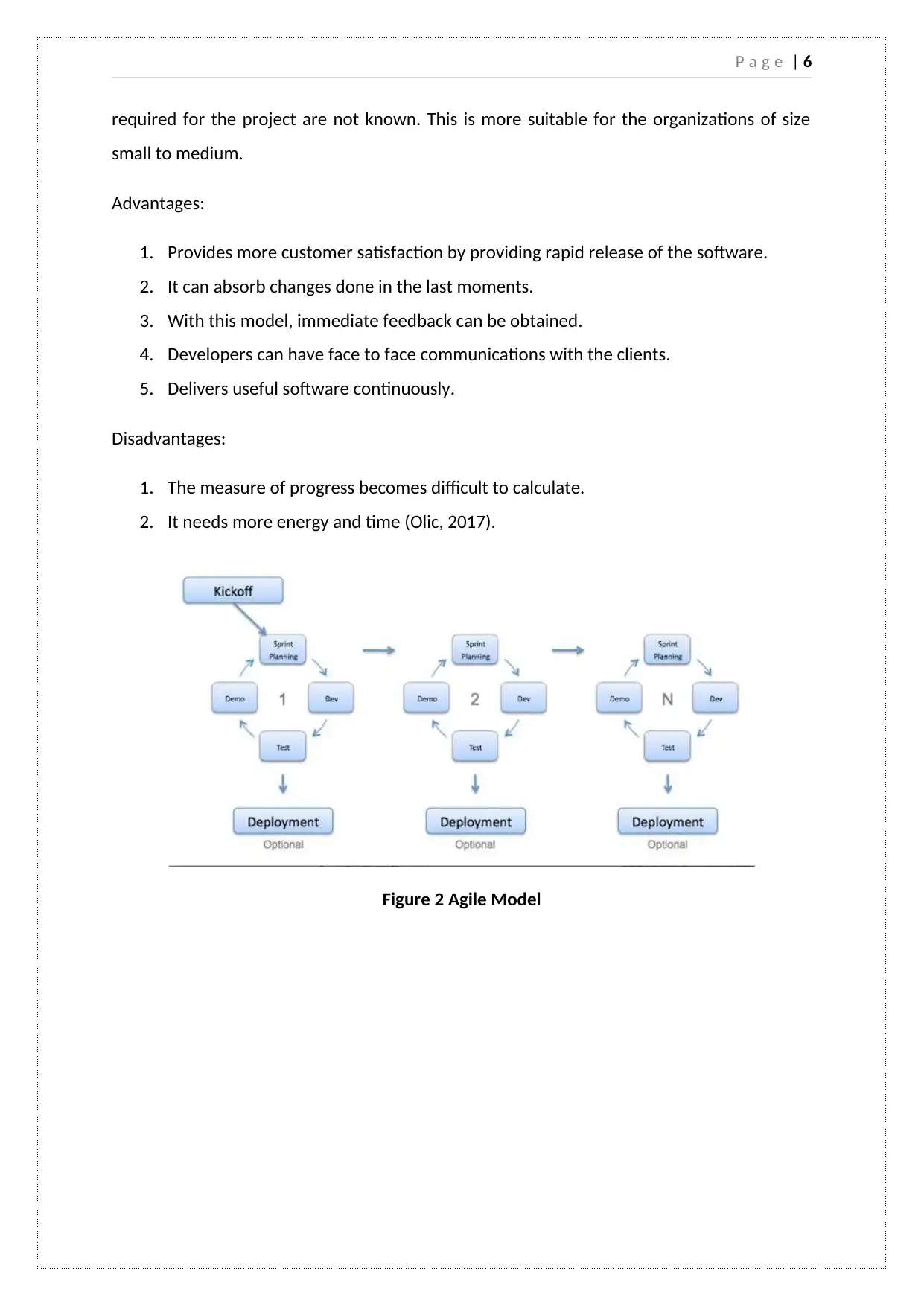
P a g e | 6
required for the project are not known. This is more suitable for the organizations of size
small to medium.
Advantages:
1. Provides more customer satisfaction by providing rapid release of the software.
2. It can absorb changes done in the last moments.
3. With this model, immediate feedback can be obtained.
4. Developers can have face to face communications with the clients.
5. Delivers useful software continuously.
Disadvantages:
1. The measure of progress becomes difficult to calculate.
2. It needs more energy and time (Olic, 2017).
Figure 2 Agile Model
required for the project are not known. This is more suitable for the organizations of size
small to medium.
Advantages:
1. Provides more customer satisfaction by providing rapid release of the software.
2. It can absorb changes done in the last moments.
3. With this model, immediate feedback can be obtained.
4. Developers can have face to face communications with the clients.
5. Delivers useful software continuously.
Disadvantages:
1. The measure of progress becomes difficult to calculate.
2. It needs more energy and time (Olic, 2017).
Figure 2 Agile Model
⊘ This is a preview!⊘
Do you want full access?
Subscribe today to unlock all pages.

Trusted by 1+ million students worldwide
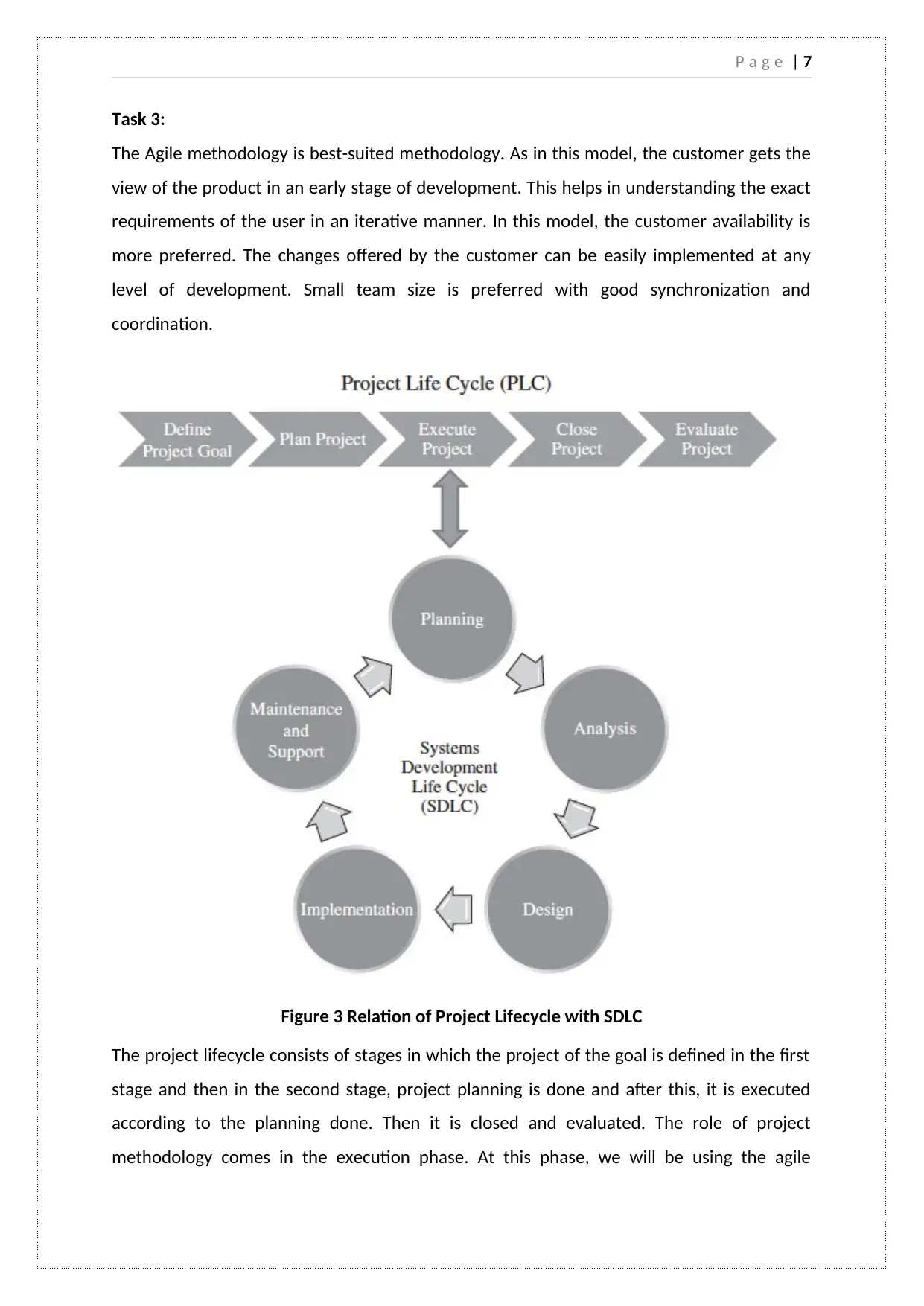
P a g e | 7
Task 3:
The Agile methodology is best-suited methodology. As in this model, the customer gets the
view of the product in an early stage of development. This helps in understanding the exact
requirements of the user in an iterative manner. In this model, the customer availability is
more preferred. The changes offered by the customer can be easily implemented at any
level of development. Small team size is preferred with good synchronization and
coordination.
Figure 3 Relation of Project Lifecycle with SDLC
The project lifecycle consists of stages in which the project of the goal is defined in the first
stage and then in the second stage, project planning is done and after this, it is executed
according to the planning done. Then it is closed and evaluated. The role of project
methodology comes in the execution phase. At this phase, we will be using the agile
Task 3:
The Agile methodology is best-suited methodology. As in this model, the customer gets the
view of the product in an early stage of development. This helps in understanding the exact
requirements of the user in an iterative manner. In this model, the customer availability is
more preferred. The changes offered by the customer can be easily implemented at any
level of development. Small team size is preferred with good synchronization and
coordination.
Figure 3 Relation of Project Lifecycle with SDLC
The project lifecycle consists of stages in which the project of the goal is defined in the first
stage and then in the second stage, project planning is done and after this, it is executed
according to the planning done. Then it is closed and evaluated. The role of project
methodology comes in the execution phase. At this phase, we will be using the agile
Paraphrase This Document
Need a fresh take? Get an instant paraphrase of this document with our AI Paraphraser

P a g e | 8
methodology of the software development lifecycle. Then it will follow the steps of the agile
in the iterative manner and deliver the quick models to the customer to obtain the
feedback. Their feedback helps in clearing the exact picture of their requirements. Then the
feedbacks will be implemented. After completing the project, it will return back to project
lifecycle where the project will be closed and final evaluation will be done (Lotz, 2013).
methodology of the software development lifecycle. Then it will follow the steps of the agile
in the iterative manner and deliver the quick models to the customer to obtain the
feedback. Their feedback helps in clearing the exact picture of their requirements. Then the
feedbacks will be implemented. After completing the project, it will return back to project
lifecycle where the project will be closed and final evaluation will be done (Lotz, 2013).
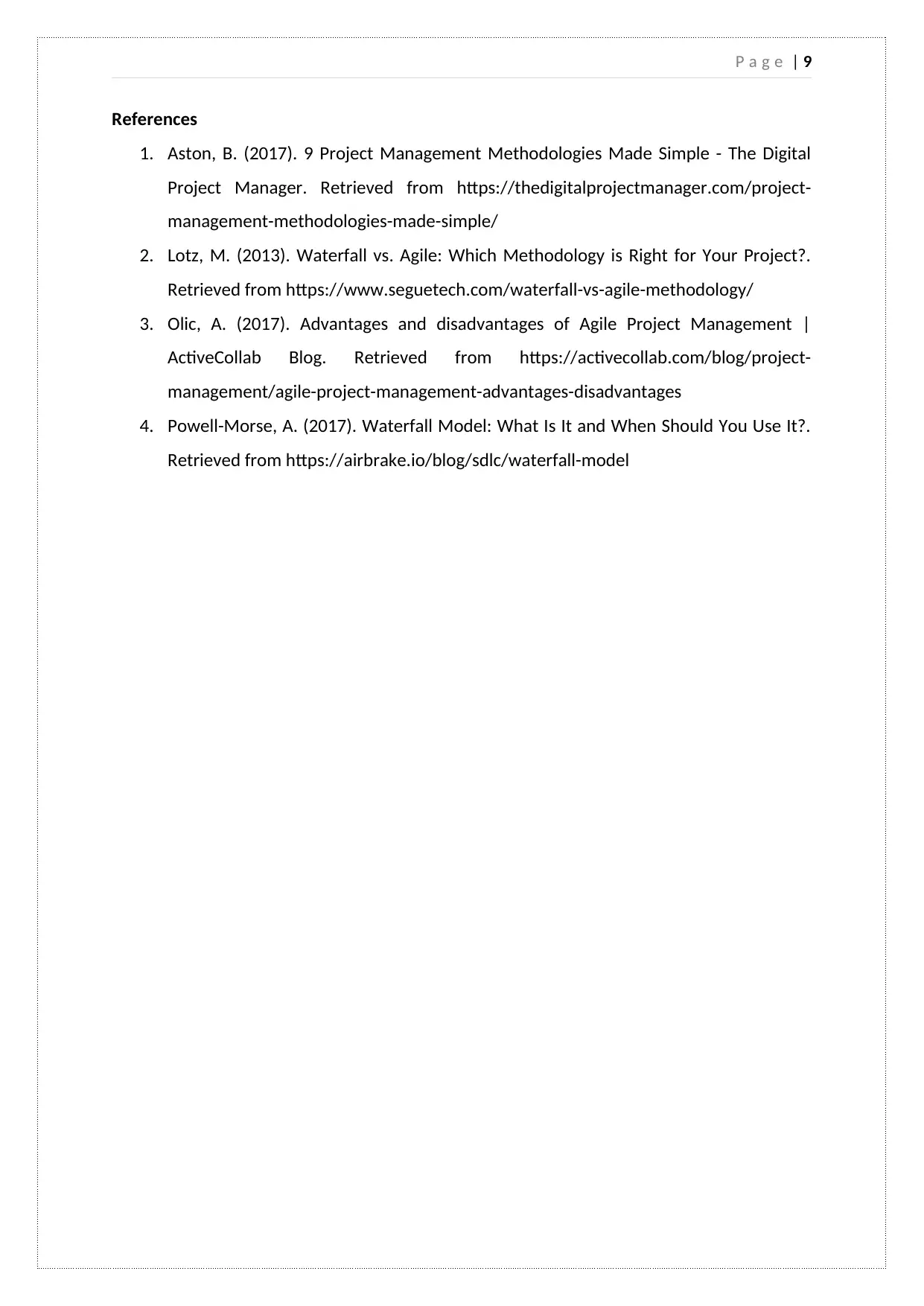
P a g e | 9
References
1. Aston, B. (2017). 9 Project Management Methodologies Made Simple - The Digital
Project Manager. Retrieved from https://thedigitalprojectmanager.com/project-
management-methodologies-made-simple/
2. Lotz, M. (2013). Waterfall vs. Agile: Which Methodology is Right for Your Project?.
Retrieved from https://www.seguetech.com/waterfall-vs-agile-methodology/
3. Olic, A. (2017). Advantages and disadvantages of Agile Project Management |
ActiveCollab Blog. Retrieved from https://activecollab.com/blog/project-
management/agile-project-management-advantages-disadvantages
4. Powell-Morse, A. (2017). Waterfall Model: What Is It and When Should You Use It?.
Retrieved from https://airbrake.io/blog/sdlc/waterfall-model
References
1. Aston, B. (2017). 9 Project Management Methodologies Made Simple - The Digital
Project Manager. Retrieved from https://thedigitalprojectmanager.com/project-
management-methodologies-made-simple/
2. Lotz, M. (2013). Waterfall vs. Agile: Which Methodology is Right for Your Project?.
Retrieved from https://www.seguetech.com/waterfall-vs-agile-methodology/
3. Olic, A. (2017). Advantages and disadvantages of Agile Project Management |
ActiveCollab Blog. Retrieved from https://activecollab.com/blog/project-
management/agile-project-management-advantages-disadvantages
4. Powell-Morse, A. (2017). Waterfall Model: What Is It and When Should You Use It?.
Retrieved from https://airbrake.io/blog/sdlc/waterfall-model
⊘ This is a preview!⊘
Do you want full access?
Subscribe today to unlock all pages.

Trusted by 1+ million students worldwide
1 out of 9
Related Documents
Your All-in-One AI-Powered Toolkit for Academic Success.
+13062052269
info@desklib.com
Available 24*7 on WhatsApp / Email
![[object Object]](/_next/static/media/star-bottom.7253800d.svg)
Unlock your academic potential
Copyright © 2020–2025 A2Z Services. All Rights Reserved. Developed and managed by ZUCOL.




